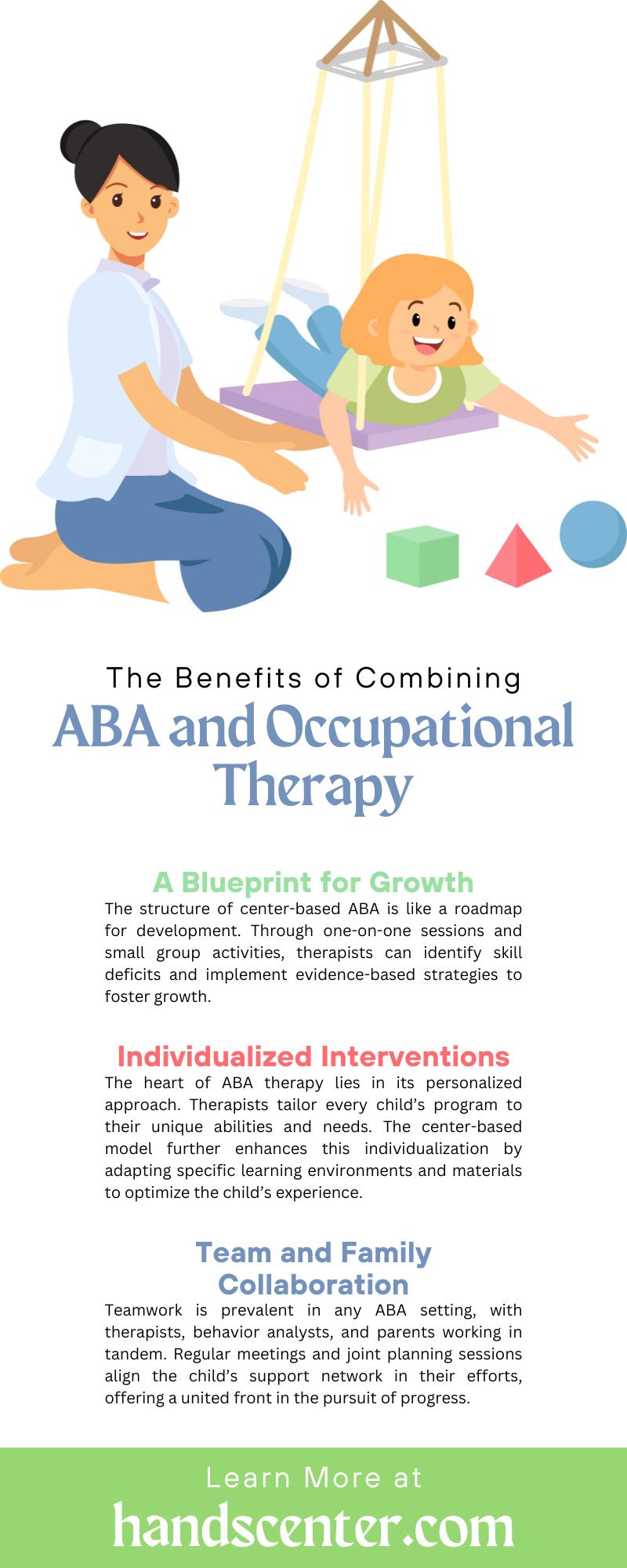The Benefits of Combining ABA and Occupational Therapy
Combining applied behavior analysis (ABA) and occupational therapy (OT) is a big step forward in helping kids, especially those with autism. This team-up helps in two ways: ABA works on improving behaviors and learning through rewards, while OT helps kids do everyday things like play, learn, and take care of themselves. This means kids get to work on lots of different skills, from social skills and behavior to stuff like dealing with things that bother their senses.
Therapists can tailor both ABA and OT to cater to the unique needs of each child, instilling a sense of confidence in parents and caregivers. While ABA is particularly effective for children with autism or those grappling with specific behaviors, OT excels in equipping children with the skills necessary for daily life.
When we combine ABA and OT, we get a super team that covers all bases, making sure kids can thrive at home, in school, and in many other environments. It’s all about giving kids the tools they need to do well in life. Parents and caregivers should know how these therapies work together to help kids be their best selves. Here are a few benefits of combining ABA and occupational therapy.
Understanding the Benefits of Center-Based ABA Therapy
Center-based ABA therapy offers a unique learning environment specifically designed to enhance targeted skills. Children enrolled in a center-based program often benefit from a consistent, structured routine, which is particularly beneficial for those who struggle with change and unpredictability. This program provides numerous advantages, including a clear roadmap for skill progression that therapists can optimize in real time to maximize learning opportunities.
A Blueprint for Growth
The structure of center-based ABA is like a roadmap for development. Through one-on-one sessions and small group activities, therapists can identify skill deficits and implement evidence-based strategies to foster growth. The center’s controlled environment minimizes distractions and allows for intensive, focused interventions, leading to quicker progress and skill acquisition.
Individualized Interventions
The heart of ABA therapy lies in its personalized approach. Therapists tailor every child’s program to their unique abilities and needs. The center-based model further enhances this individualization by adapting specific learning environments and materials to optimize the child’s experience. The result is an intervention that’s both personal and potent, with the child at the center of every therapeutic decision.
Team and Family Collaboration
Teamwork is prevalent in any ABA setting, with therapists, behavior analysts, and parents working in tandem. Regular meetings and joint planning sessions align the child’s support network in their efforts, offering a united front in the pursuit of progress.
Understanding the Role of Occupational Therapy
While ABA focuses on behavior, occupational therapy addresses the essential skills that underpin a child’s daily life. From the moment a child wakes to the minute they lay their head down, occupational therapy interventions adapt and grow alongside them.
Holistic Approach to Development
Occupational therapy takes a holistic view of a child’s development, considering the interaction between their physical, cognitive, and social-emotional milestones. By engaging children in purposeful activities that replicate everyday tasks, OT bridges the gap between skill development and their functional application, ensuring that growth is meaningful and relevant to a child’s life.
Environmental Enrichment
Just as the environment of center-based ABA is structured, so is the environment in which OT takes place. Therapists use sensory-rich spaces and intentionally designed activities to offer children the right level of challenge and support. This approach teaches them to adapt to varying sensory stimuli and physical demands, preparing them to face the dynamic world outside the therapy room.
Skill Generalization
One of the primary aims of OT is to facilitate skill generalization, the ability to transfer learned skills to new environments and tasks. By practicing skills in different settings and with a variety of materials, children reinforce those abilities and learn to apply them to various contexts, setting the stage for success in school, home, and their community.
Practical Tips for Dual Therapy Integration at Home and School
For parents and educators, the collaboration of ABA and OT doesn’t stay in therapy sessions. It can extend into the very fabric of a child’s daily life, offering continuous support and reinforcement of learned skills.
Create an Environment of Learning
Adapt your home or classroom to be a supportive learning environment. Structure time for focused activities that mimic those practiced in therapy, providing the consistent routine that children crave. Tailor these activities to challenge and engage with the purpose of skill-building in mind.
Routines and Schedules
Establish clear routines and visual schedules that help children anticipate and understand the sequence of activities. Consistency in the approach between therapy and everyday life boosts a child’s ability to transfer learned skills and strategies.
Sensory Integration Techniques
Incorporate sensory-integration techniques and tools into the child’s surroundings. From weighted blankets to quiet spaces, these tools can help children self-regulate, fostering a sense of calm and readiness for learning and exploration.
The Power of Positive Reinforcement
Use the principles of ABA by employing positive reinforcement to encourage and maintain desired behaviors. Be clear and consistent in your praise and rewards, emphasizing specific achievements and the path to their accomplishment.
Paving a Path to Success for Every Child
The combined force of ABA and OT is a testament to the maxim that the whole is greater than the sum of its parts. Each therapy brings a unique set of tools to the table, but together, they offer a comprehensive approach that addresses the multifaceted needs of children. Whether your child is taking their first steps in skill development or well on their way to independence, this collaborative model can pave the path to success.
By understanding the benefits of combining ABA and OT and recognizing how they complement each other, you can become a partner in your child’s therapy journey. Through shared goals, consistent routines, and a supportive atmosphere, the benefits of this dual approach become not just theoretical but tangible in your child’s everyday achievements.
For parents and educators alike, advocating for a collaborative ABA and OT approach that respects the individuality of a child’s developmental trajectory is essential. For more information about our center-based ABA therapy, contact our team at HANDS Center today.







